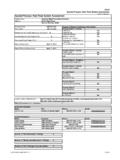Transcription of Current WHO GUIDE
1 Current WHO GUIDE . for Rabies Pre and Post-exposure Treatment in Humans world health organization Department of Communicable Diseases Surveillance and Response 1 Last update: November 2002. General considerations in rabies post-exposure treatment WHO strongly advocates the use of modern (purified products prepared on cell-culture) vaccines for PET that comply with WHO criteria for potency, innocuity and have been assessed satisfactorily in humans in well-designed field trials;. WHO supports the trend to abandon completely the production of brain-tissue vaccines;. Participants from 14 Asian countries at the WHO/M rieux Foundation 4th International Symposium on Rabies Control in Asia, Hanoi Vietnam issued a resolution in March 2001. urging Asian countries that still produce nerve tissue vaccine to discontinue its production by 2006. world health organization Department of Communicable Diseases Surveillance and Response 2.
2 General considerations in rabies post-exposure treatment Immediate washing/flushing and disinfection of the wound and rapid administration of purified immunoglobulin and modern vaccine according to the modalities described in these guidelines assure prevention of infection in almost all circumstances Rabies post-exposure treatment is an emergency and as a general rule should not be delayed or deferred;. does not have contraindications if modern purified rabies biologicals are used;. must be applied using vaccine regimens and routes of administration that have been proven to be safe and effective. world health organization Department of Communicable Diseases Surveillance and Response 3. General considerations in rabies post-exposure treatment Rabies post-exposure treatment is an emergency! wounds should be treated immediately. Vaccine and serum therapy (when required for the latter) instituted as soon as possible, initiation of treatment should not await the results of laboratory diagnosis or be delayed by dog observation when rabies is suspected, pregnancy and infancy are never contraindications to rabies post-exposure treatment, persons who present for evaluation and treatment even months after having been bitten should be dealt with in the same manner as if the contact occurred recently.
3 world health organization Department of Communicable Diseases Surveillance and Response 4. General considerations in rabies post-exposure treatment Deferring treatment: an exception in rabies endemic countries or areas! u If the species is unlikely to be infected with rabies, wait for laboratory diagnosis if results can be obtained within 48 hours;. u If the dog at the origin of exposure is more than a year old and has a vaccination certificate indicating that it has received at least 2 doses of a potent vaccine, the first not earlier than 3 months of age and another within 6 to 12 months later, observe the dog 10 days. If the dog shows any sign of illness during the observation period, the patient should receive full rabies post-exposure treatment urgently. world health organization Department of Communicable Diseases Surveillance and Response 5. Rabies post-exposure treatment modalities Wound treatment : u should be immediate u is essential even if the person presents long after exposure u consists of: - immediate washing and flushing with soap and water, or water alone, - disinfecting with ethanol (700ml/l) or iodine (tincture or aqueous solution).
4 world health organization Department of Communicable Diseases Surveillance and Response 6. Rabies post-exposure treatment modalities Definition of categories of exposure and use of rabies biologicals: CategoryIII: Category III: Singleor Single ormultiple multipletransdermal transdermalbites, bites,scratches scratchesor orcontamination contaminationofofmucous mucous membranewith membrane withsaliva saliva( ( ). licks). useimmunoglobulin use immunoglobulinplus plusvaccine vaccine Category II: Category II: Minorscratches Minor scratchesor orabrasions abrasionswithout withoutbleeding bleedingor orlicks lickson onbroken brokenskin skinand and nibblingofofuncovered nibbling uncoveredskin skin usevaccine use vaccinealone alone Category II:: Category Touching,feeding Touching, feedingofofanimals animalsor orlicks lickson onintact intactskin skin noexposure no exposuretherefore thereforeno notreatment treatment ififhistory historyreliable reliable world health organization Department of Communicable Diseases Surveillance and Response 7.
5 Rabies post-exposure treatment modalities Administration of rabies immunoglobulin (RIG). u Infiltrate into the depth of the wound and around the wound as much as anatomically feasible of the RIG should be infiltrated around the wound any remainder should be injected at an intramuscular site distant from that of vaccine inoculation into the anterior thigh u Quantities/volume of RIG: 20IU/ kg for Human RIG or 40 IU/ kg of Equine RIG. the total recommended dose should not be exceeded if the calculated dose is insufficient to infiltrate all wounds, sterile saline may be used to dilute it 2 to 3 fold to permit thorough infiltration world health organization Department of Communicable Diseases Surveillance and Response 8. Rabies post-exposure treatment modalities Non-specific care u Postpone suturing if possible; if suturing is necessary ensure that RIG has been applied locally;. u Apply antimicrobials and tetanus toxoid if necessary world health organization Department of Communicable Diseases Surveillance and Response 9.
6 Rabies post-exposure treatment intramuscular regimens Two intramuscular schedules for modern vaccines: u Vaccines should not be injected into the gluteal region;. u Classical 5 dose intramuscular regime ( Essen regimen): one dose of the vaccine should be administered on days 0, 3, 7, 14 and 28 in deltoid region or, in small children, into the antero-lateral area of the thigh muscle;. u As an alternative, the 2-1-1 regimen may be used. Two doses are given on day 0 in the deltoid muscle, right and left arm. In addition one dose in the deltoid muscle on day 7. and one on day 21. world health organization Department of Communicable Diseases Surveillance and Response 10. General considerations on intradermal rabies post-exposure treatment u As these regimens require considerably less vaccine than the intramuscular regimens the method is particularly appropriate where vaccine or money is in short supply.
7 Intradermal injections reduce the volume of vaccine required and vaccine cost by 60% to 80%. world health organization Department of Communicable Diseases Surveillance and Response 11. General considerations on intradermal rabies post-exposure treatment u The decision to implement economical intradermal post-exposure treatment rests with government agencies that define rabies prevention and treatment policies in their own countries. u When the intradermal route is used, precautions include staff training, conditions and duration of vaccine storage after reconstitution, use of appropriate 1 mL syringe and short hypodermic needles. world health organization Department of Communicable Diseases Surveillance and Response 12. General considerations on intradermal vaccination against rabies Three vaccines have proven to be efficacious u Human diploid cell vaccine (HDCV) RabivacTM. u Purified vero cell vaccine (PVRV) VerorabTM, ImovaxTM , Rabies vero TM, TRC.
8 Verorab TM. u Purified chick embryo cell vaccine (PCECV) Rabipur TM. world health organization Department of Communicable Diseases Surveillance and Response 13. General considerations on intradermal vaccination against rabies Recommended intradermal regimens and vaccines for use by the intradermal route v 8-site intradermal method (8-0-4-0-1-1) for use with HDC (RabivacTM )and PCECV (Rabipur TM). v The 8 sites regimen should be particularly considered in emergency situations when no RIG is available;. v 2-site intradermal method (2-2-2-0-1-1) for use with PVRV (VerorabTM, ImovaxTM , Rabies vero TM, TRC Verorab TM ) and PCECV (Rabipur TM). world health organization Department of Communicable Diseases Surveillance and Response 14. Intradermal PET regimens for modern rabies vaccines 8-siteintradermal 8-site intradermalmethod method('8-0-4-0-1-1'). ('8-0-4-0-1-1'). for use with u human diploid cell vaccine (HDCV) (RabivacTM ) and u purified chick embryo cell vaccine (PCECV) (Rabipur TM).
9 Both vaccines at 0,1 mL per intradermal site world health organization Department of Communicable Diseases Surveillance and Response 15. Intradermal PET regimens for modern rabies vaccines 2-siteintradermal 2-site intradermalmethod method('2-2-2-0-1-1'). ('2-2-2-0-1-1'). The volume per intradermal site is: u 0,1 mL for PVRV (VerorabTM, ImovaxTM , Rabies vero TM, TRC Verorab TM ). u 0,2 mL for PCECV (Rabipur ) or as an option u 0,1 mL for PCECV (Rabipur ) may be considered for use by national health authorities. This does not apply to any other vaccine brand. world health organization Department of Communicable Diseases Surveillance and Response 16. Intradermal route and rabies vaccine potency requirements u The antigenic potency of all the WHO approved vaccines has proven similar and is well above the minimum value of IU/ampoule;. u WHO minimum potency requirement for human rabies vaccines for intradermal use should not be increased beyond 2,5 IU (per single intramuscular dose) by national authorities unless the need for a change is substantiated by clinical or field studies.
10 world health organization Department of Communicable Diseases Surveillance and Response 17. Intradermal route and rabies vaccine potency requirements u To be approved for id use, any new candidate vaccine should be proven potent by the NIH test and its immunogenicity and safety should be demonstrated with the volume intended for humans;. u Any country willing to adopt an id regimen of proven efficacy with the recommended vaccines need not repeat immunogenicity studies in their own population. world health organization Department of Communicable Diseases Surveillance and Response 18. Vaccine vial insert for intradermal application of rabies vaccines For vaccines recommended by WHO to be used intradermally, the vaccine insert should contain a statement saying: This vaccine is of sufficient potency to allow its safe use in one of the WHO recommended intradermal post-exposure regimens in countries where relevant national authorities have approved the intradermal route for rabies PET.
















